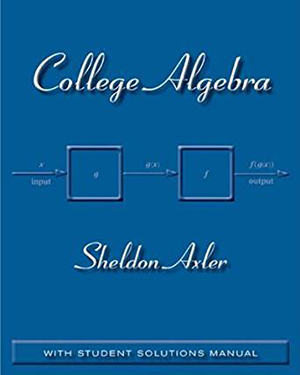
College Algebra, 1st Edition
By Sheldon Axler
College Algebra focuses on depth, not breadth of topics by exploring necessary topics in greater detail. Students benefit from straightforward definitions and plentiful examples of complex concepts. With a “Student Solutions” section integrated following each area of study, students are encouraged to go back and review the materials covered as they are working through the problems and exercises. Over 1300 algorithmic questions give students immediate feedback on essentially endless practice. Additionally, students have access to over 200 Guided Online (GO) Tutorial problems that walk them through the problem step by step.
Schedule a Demo Sign Up for a Test Drive Adopt WileyPLUSWant to learn more about WileyPLUS? Click Here
Read, Study, and Practice
Students learn course concepts using the complete online eTextbook, flashcards, crossword puzzles, practice questions, videos, and animations. Organized by learning objective, students can filter for relevant learning resources based on what they need to study most and print any section of the eTextbook.
ORION Adaptive Practice (when available)
Every student has a different starting point, and adaptive practice provides endless opportunities for practice to effectively prepare for class or quizzes and exams. Active retrieval of information with practice questions is proven to improve retention of information better than re-reading or reviewing the material, and students who use adaptive practice to prepare for exams do significantly better than those who do not. Students begin with a quick, chapter-level diagnostic to determine their initial level of understanding, and they can use the dashboard and quick reports to see what topics they know and don’t know.
Assignments
Students who fully engage in WileyPLUS assignments do better in the course by more than a letter grade. Auto-graded assignments give students immediate feedback based on flexible assignment settings determined by the instructor, while the notification center allows students to set their own email notification policies to stay on track.
Instructors can select from extensive and reliable question banks to create and deploy reading, practice, homework, pre-post lectures, and assessment assignments. This course includes essay, label drag-and-drop, multiple choice, text entry, and true-/false question types.
Gradebook
Students know where they stand on WileyPLUS assignments, and they can track progress by learning objective.
Instructors have insights into student performance at the granular question attempt and can track trends by individual student, assignment, or learning objective. Flexible policies allow instructors to change points, set assignment weighing policies, extend individual due dates, or drop the lowest grade.
Sheldon Axler is well-known within the mathematics community. He has an Ivy League education, having received his AB in mathematics from Princeton in 1971, and his PhD in mathematics from UC Berkeley in 1975. Currently, Sheldon is the Dean of the College of Science and Engineering at SFSU. Previously, he held teaching positions at Michigan State, UC Berkeley, Indiana University, and MIT. He has received numerous grants, awards, and fellowships throughout his career. He regularly speaks at conferences and conventions and has done extensive writing in his discipline. Notably, he is the author of a successful textbook for the second course in Linear Algebra, published with Springer and has held several editorial positions for mathematics journals and is currently a series editor for Springer.
As the author for Wiley’s Precalculus: A Prelude to Calculus, Sheldon has shown himself an able and willing promoter of his title, garnering the interest of his colleagues nationwide and proving himself a valuable and responsive resource for our sales force.
Chapter 1. The Real Numbers
Chapter 2. Combining Algebra and Geometry
Chapter 3. Functions and Their Graphs
Chapter 4. Polynomial and Rational Functions
Chapter 5. Exponents and Logarithms
Chapter 6. e and the Natural Logarithm
Chapter 7. Systems of Equations and Inequalities
Chapter 8. Sequences, Series, and Limits

